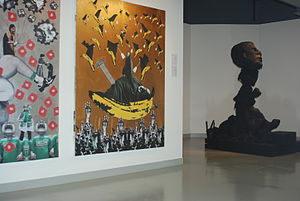 | |
 | |
| Established | 1999 |
|---|---|
| Location | Jerusalem |
| Type | Art and politics |
| Website | www |
Museum on the Seam is a socio-political contemporary art museum in Jerusalem, Israel.
 | |
 | |
| Established | 1999 |
|---|---|
| Location | Jerusalem |
| Type | Art and politics |
| Website | www |
Museum on the Seam is a socio-political contemporary art museum in Jerusalem, Israel.
Founded in 1999, Museum on the Seam is housed in a neo-classical building designed by Andoni Baramki, a Palestinian Arab architect who built it as a family residence. [1] The property was appropriated by Israel after 1948. According to the museum website, the museum focuses on "controversial social issues for public discussion,” with exhibitions on social issues like the right to protest, the decline of Western hegemony, and state/private home relationships. [2]
Museum on the Seam has been cited by The New York Times as one of the world's 29 cultural 'one must-see-before-I-die destinations.' [3] [4] According to its public presentations, it brings social and moral change in face of a complex and conflict-ridden reality.
The museum was established by Raphie Etgar. It has been supported for decades by the Holtzbrink Family Foundation. [3] through the Jerusalem Foundation. Leading contemporary artists have shown their work at this museum, including Anselm Kiefer, Bruce Nauman, Bill Viola, Christian Boltanski, Sophie Calle, Wim Wenders, Thomas Hirschhorn, Gilbert & George, Paul McCarthy, Barbara Kruger, Jenny Holzer, Douglas Gordon, William Kentridge, Santiago Sierra, Alfredo Jaar, Edward Burtynsky, Yael Bartana, Michal Rovner, Dani Karavan, Moshe Gershuni, Micha Ullman, Joshua Neustein, Larry Abramson, Sigalit Landau, Tsibi Geva, Menashe Kadishman, Miki Kratsman, Gilad Ophir, Michal Na'aman and many others. [5]
The house was built to serve as his home by the Christian Arab architect Andoni Baramki in 1932, on one dunam of property purchased from the Turjman family. [1] The Baramki family was forced to flee as refugees, after a stray bullet almost killed the architect's wife while she was sitting in her living room, [6] during the 1948 Palestinian expulsion and flight [7] during the 1948 Arab–Israeli War.
The Baramki home was turned into an Israeli military outpost, called the "Tourjman Post" [8] situated on the border or no man's land between Israel and Jordan overlooking the Mandelbaum Gate, which served as the only passage between the two parts of the divided city at the time. [1] The finely wrought window arches were filled with concrete to form turrets. [8] During the battles of the 1967 War, the house suffered hits from shells and bullets which left their marks on the building and are apparent to this day. [8]
At war's end, the Baramkis crossed over with their keys and title-deeds but were rebuffed. [8] As was the case with the Turjmans, [1] all efforts by Andoni and his son Gabi Baramki, longtime President of Birzeit University in the West Bank, to return to and repossess the family home through recourse in Israeli courts, failed. The reasons were various: it was claimed initially that the site was required for military security, then that it was in a hazardous state, in need of substantial repairs, and finally that it fell under Israeli laws in a united Jerusalem, and, despite their presence, the family were classified as absentee property owners. [8] Gabi Baramki was allowed only one visit, [7] in 1999. [9] and Baramki[ which? ] regarded it as "stolen property". [6]
In 1981 the military outpost was renovated and renamed as the "Tourjman Post Museum" commemorating the reunification of the city. The museum mounted exhibits of the guns, mortars and other weapons used in its defense. [8]
In 1999 the building underwent change and a new permanent exhibition, calling for tolerance and mutual understating between people in the region, was displayed. On the day of its dedication, it was opened ostensibly as a site for 'peace, tolerance,... dialogue, understanding and coexistence'.[ citation needed ]
Since 2005, the building serves as a home to the Museum on the Seam - a socio-political contemporary art museum dedicated to dialogue and mutual understanding.[ citation needed ]
In 2000 Museum on the Seam produces, as an initiative by Raphie Etgar, the exhibition COEXISTANCE: [10] an international project that incorporates many leading poster designers from around the globe. The project was displayed in over 35 cities in different continents and called for mutual understanding between fellow nations and religions. Its global Journey was endorsed and supported by world leaders and thinkers.

The Arab citizens of Israel are the country's largest ethnic minority. They are colloquially referred to in Arabic as either 48-Arabs or 48-Palestinians, denoting the fact that they have remained in Israeli territory since the Green Line was agreed upon between Israel and the Arab countries as part of the 1949 Armistice Agreements. According to several sources, the majority of Arabs in Israel now prefer to be identified as Palestinian citizens of Israel. International media outlets often use the term "Arab-Israeli" or "Israeli-Arab" to distinguish Israel's Arab citizens from the Palestinian Arabs residing in the Israeli-occupied territories. They are formerly, or are descended from, those Arabs who belonged to the British Mandate for Palestine through Palestinian Citizenship Order 1925. Speakers of both Arabic and Hebrew, they self-identify in a wide range of intersectional civic, national, and religious identities.

Tamer Nafar is a Palestinian rapper, actor, screenwriter and social activist of Israeli citizenship. He is the leader and a founding member of DAM, the first Palestinian hip hop group.
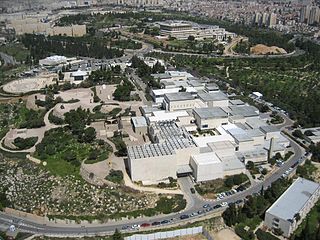
The Israel Museum is an art and archaeological museum in Jerusalem. It was established in 1965 as Israel's largest and foremost cultural institution, and one of the world's leading encyclopaedic museums. It is situated on a hill in the Givat Ram neighborhood of Jerusalem, adjacent to the Bible Lands Museum, the Knesset, the Israeli Supreme Court, and the Hebrew University of Jerusalem.

Birzeit University Arabic: جامعة بيرزيت is a public university in the West Bank, Palestine, registered by the Palestinian Ministry of Social Affairs as a charitable organization. It is accredited by the Ministry of Higher Education and located in the outskirts of Birzeit, West Bank, near Ramallah. Established in 1924, as an elementary school for girls, Birzeit became a university in 1975.
Avraham Sela is an Israeli historian and scholar on the Middle East and international relations.
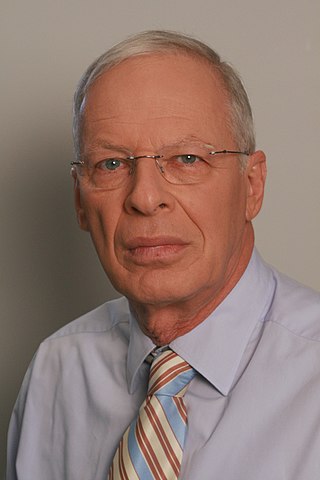
Ehud Yaari is an Israeli journalist, author, television personality and political commentator.

Palestinian art is a term used to refer to paintings, posters, installation art and other visual media produced by Palestinian artists.

Al-Walaja is a Palestinian village in the West Bank, four kilometers northwest of Bethlehem. It is an enclave in the Seam Zone, near the Green Line. Al-Walaja is partly under the jurisdiction of the Bethlehem Governorate and partly of the Jerusalem Municipality. According to the Palestinian Central Bureau of Statistics, the village had a population of 2,671 in 2017. It has been called 'the most beautiful village in Palestine'.

Udi Aloni is an Israeli American filmmaker, writer, visual artist and political activist whose works focus on the interrelationships between art, theory, and action.

Visual arts in Israel or Israeli art refers to visual art or plastic art created by Israeli artists or Jewish painters in the Yishuv. Visual art in Israel encompasses a wide spectrum of techniques, styles and themes reflecting a dialogue with Jewish art throughout the ages and attempts to formulate a national identity.
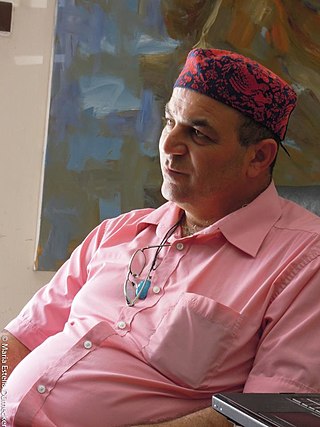
Ahmad Canaan is a painter and sculptor.

The Israeli Committee Against House Demolitions (ICAHD) is a group opposed to Israeli settlements, which describes itself as "an Israeli peace and human rights organization dedicated to ending the occupation of the Palestinian territories and achieving a just peace between Israelis and Palestinians."

Raphie Etgar is an Israeli artist and curator who has served as artistic Director of Museum on the Seam since its establishment in 2000 and until 2021.

Jack Persekian is a Palestinian artist and curator from Jerusalem. He is of Armenian descent and a United States citizen.

The Coexist image is an image created by Polish, Warsaw-based graphic designer Piotr Młodożeniec in 2000 as an entry in an international art competition sponsored by the Museum on the Seam for Dialogue, Understanding and Coexistence. The original version was one of dozens of works displayed as large outdoor posters in Jerusalem in 2001. It is designed to represent tolerance between religions.

Nino (Chananya) Herman is an Israeli art-photographer.

Ruth Schloss was an Israeli painter and illustrator. Major themes in her work were Arabs, transition camps, children and women at eye-level. She expressed an egalitarian, socialist view via realism in her painting and drawing.
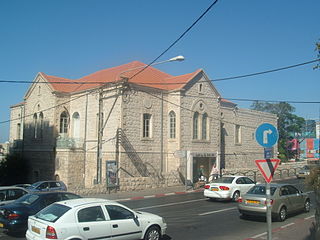
Beit Ha'Gefen — The Arab-Jewish Cultural Center in Haifa is a multi-cultural organization that aims to bring together Arabs and Jews and promote coexistence and tolerance.

Shula Kehset is an Israeli social and political activist and entrepreneur, Mizrahi feminist, artist, curator, writer, educator, and publisher; one of the founders and the executive director of the MIzrahi feminism movement, "Ahoti – for Women in Israel".
Albert Aghazarian was a Palestinian historian, translator, university administrator, and political spokesperson from Jerusalem. He served in various capacities during his career, but he is most remembered for his role in the public relations office at Bir Zeit University in the 1980s–1990s and for serving as a press official during the 1991 Madrid Conference. He made numerous media and conference appearances during his career and worked as a historian, writer, editor, and translator throughout his life, with a special focus on the history of Jerusalem.
